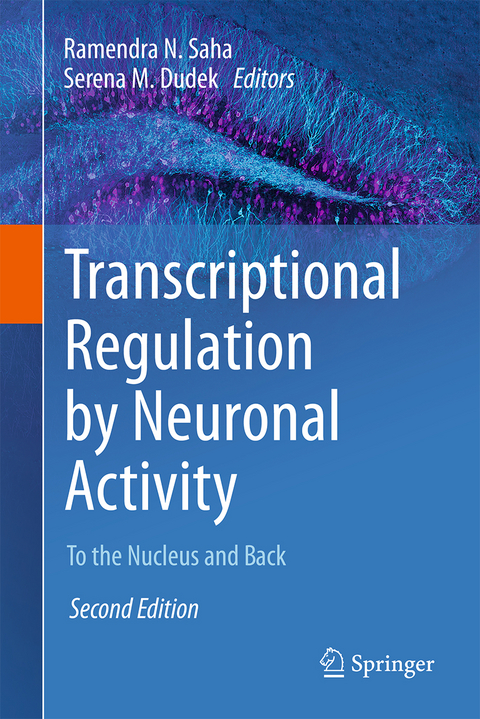
Transcriptional Regulation by Neuronal Activity
Springer International Publishing (Verlag)
978-3-031-68549-1 (ISBN)
This book discusses the regulation of gene transcription by neuronal activity that is evident in a large number of neuronal processes ranging from neural development and refinement of neuronal connections to learning and response to injury. Transcriptional Regulation by Neuronal Activity: To the Nucleus and Back, 2nd edition illustrates how signals are transmitted to the nucleus in response to neuronal activity, which genes are regulated and how this is achieved, and how these changes in gene expression alter neuronal function. The aim of this second edition is to highlight key advances in the field since the first edition. The book is divided into four sections. The first highlights how signals get to the nucleus from the membrane in response to synaptic or neuronal activity. Included are chapters on the pathways that transmit signals from synapses to nuclei. The second section focuses on epigenetic regulatory processes of activity-induced gene transcription, an area that has exploded in the past few years. The third section navigates the role of activity-induced genes in physiological processes such as learning and memory, and human developmental disorders such as those associated with the autism spectrum. The fourth section highlights groundbreaking technological advances in the field, which have allowed activity-regulated transcription to be used as a tool to study learning and memory.
Ramendra N Saha, Ph.D., is an Associate Professor at the University of California (UC) Merced where he is also the co-director of the UC Merced Center for Interdisciplinary Neuroscience. Ramen did his post-doctoral training with Serena Dudek at the National Institute of Environmental Health Sciences, United States National Institutes of Health where he studied molecular mechanisms of activity-induced neuronal immediate early gene transcription. Now, his laboratory at UC Merced continues to study signaling and epigenetic mechanisms of excitation-transcription coupling. Ramen serves on the editorial board of Environmental Epigenetics. ORCID ID: 0000-0002-5494-2584
Serena M. Dudek, Ph.D., is a Senior Investigator and the Deputy Chief of the Neurobiology Laboratory at the National Institute of Environmental Health Sciences, United States National Institutes of Health. Her research focuses on the molecular and cellular mechanisms regulating synaptic plasticity in the developing nervous system to better understand how environmental factors shape the adult brain. Dr Dudek is best known for her early work on long-term synaptic depression (LTD) and pruning, regulation of neuronal gene transcription by action potentials, and synaptic plasticity in hippocampal area CA2. She serves on the editorial boards of Hippocampus and the Journal of Neuroscience. In addition, she is the recipient of the 2009 A.E. Bennett Research Award from the Society of Biological Psychiatry. ORCID ID: 0000-0003-4094-8368
Section 1: Activity-regulated Transcription: Getting to the Nucleus.- Fos/AP-1 as an exemplar for the study of neuronal activity-dependent gene regulation.- Calcium signaling to the nucleus.- Protein transport from synapse-to-nucleus and the regulation of gene expression.- Gene regulation by nuclear calcium and its antagonism by NMDAR/TRPM4 signaling.- Chemoelectric signaling, protein translocation and neuronal transcription.- Section 2: Activity-regulated Transcription: Epigenetic Regulation.- Histone variants in neuronal transcription and behavioral regulation.- Genome and epigenome engineering approaches to studying neuronal activity-dependent transcriptional enhancers.- Higher-order genome organization in the control of neuronal identity and neural circuit plasticity.- Chromatin remodelers in neuronal gene transcription.- Section 3: Activity-regulated Transcription: Role in Nervous System Function.- Nature and nurture converge in the nucleus to regulate activity-dependent neuronal development.- Roles for the MEF2 transcription factors in synapse and circuit development and plasticity.- Activity-related transcription: role in addiction.- Epigenetic priming of activity-dependent transcription in drug addiction.- Molecular intersection of activity-dependent gene expression and behavior: the transcriptomic signature of long-term memory consolidation.- Perturbations to stimulus-dependent gene activity patterns in neurodegenerative disorders.- Section 4: New Tools to Study and Use Activity-regulated Transcription.- Genome editing technologies for investigation of activity dependent transcription.- Imaging activity dependent gene expression in neurons: RNA tagging technologies.- Optogenetic approaches to study IEG activation.- New Genome-wide Technologies to Study Activity-regulated Transcription.
| Erscheinungsdatum | 14.11.2024 |
|---|---|
| Zusatzinfo | XI, 595 p. 73 illus., 68 illus. in color. |
| Verlagsort | Cham |
| Sprache | englisch |
| Maße | 155 x 235 mm |
| Themenwelt | Medizin / Pharmazie ► Medizinische Fachgebiete ► Neurologie |
| Medizin / Pharmazie ► Studium | |
| Naturwissenschaften ► Biologie ► Genetik / Molekularbiologie | |
| Naturwissenschaften ► Biologie ► Humanbiologie | |
| Schlagworte | calcium-dependant signaling • chromatin remodelers • enhancers • gene expression • gene regulation • gene transcription • Histone Modifications • Intercellular signaling • nervous system • neurons • Neuroscience • Plasticity • role in addiction • role in development • role in learning and memory • role in sleep • synapse-to-nucleus signaling • synaptic plasticity |
| ISBN-10 | 3-031-68549-0 / 3031685490 |
| ISBN-13 | 978-3-031-68549-1 / 9783031685491 |
| Zustand | Neuware |
| Informationen gemäß Produktsicherheitsverordnung (GPSR) | |
| Haben Sie eine Frage zum Produkt? |
aus dem Bereich


